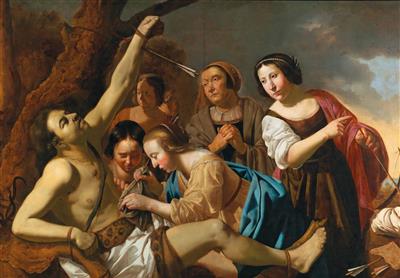Jan van Bijlert

(Utrecht 1597/98–1671)
Saint Sebastian attended by Saint Irene,
oil on canvas, 139.7 x 192.4 cm, framed
Provenance:
Private collection, South America;
Private collection, Florida, USA, until 2010
Paul Huys Janssen writes in his certificate from 18 April 2011, which accompanies this lot: ‘This painting should be dated circa 1630. It still shows the characteristics of Van Bijlert’s earlier Caravaggesque paintings with cropped-up figures and a high sense of dramatisation. Yet he also started to use lighter colours and paint in a brighter style. Compared to Jan van Bijlert’s painting of 1624, which depicted exactly the same subject (Count Harrach Collection, Rohrau, Austria), the differences are clear. The earlier painting only shows three people, the Saint, Irene, and a servant. In our painting, however, there are many more people of whom Irene may be the woman to the right giving orders to her servants to attend Sebastian. The painting from 1624 is set against a dark background, while in our case the painter has included a landscape. There are similarities in the figure of Sebastian, who in both cases is hanging unconsciously with one arm tied to the tree.
Several Utrecht artists painted the martyrdom of Saint Sebastian. A fine example showing the influence of international Mannerism was made by Joachim Wtewael in 1600 (The Nelson-Atkins Museum of Art, Kansas City, Missouri, USA). Around 1620/23, Gerard van Honthorst depicted Saint Sebastian as a single figure being shot with four arrows (National Gallery, London). The subject where Sebastian is attended by Irene was done by Dirck van Baburen in 1623 (Kunsthalle, Hamburg), Jan van Bijlert in 1624, as mentioned above, and Hendrick ter Brugghen in 1625 (Allen Memorial Art Museum, Oberlin, Ohio, USA).
Sebastian lived in the third century A.D. and was an officer in the Roman army. He changed his belief and converted to Christianity. When this was discovered, he was sentenced to being shot with arrows. Left to die, he was found and succoured by Irene, a widow. Sebastian was later flogged to death. The story of Sebastian was a popular subject in the visual arts. Under the influence of the Counter-Reformation it received strong interest at the beginning of the seventeenth century. Sebastian was applauded as one of the best militant defenders and martyrs of the church. In this vision, Irene has become the model of a virtuous and pious woman. Sebastian was regarded as one of the principal protectors against the plague and it is therefore possible that representations of Saint Sebastian were executed in response to an epidemic of the plague.
Specialist: Damian Brenninkmeyer
 Damian Brenninkmeyer
Damian Brenninkmeyer
+43 1 515 60 403
damian.brenninkmeyer@dorotheum.at
23.10.2018 - 18:00
- Estimate:
-
EUR 150,000.- to EUR 200,000.-
Jan van Bijlert
(Utrecht 1597/98–1671)
Saint Sebastian attended by Saint Irene,
oil on canvas, 139.7 x 192.4 cm, framed
Provenance:
Private collection, South America;
Private collection, Florida, USA, until 2010
Paul Huys Janssen writes in his certificate from 18 April 2011, which accompanies this lot: ‘This painting should be dated circa 1630. It still shows the characteristics of Van Bijlert’s earlier Caravaggesque paintings with cropped-up figures and a high sense of dramatisation. Yet he also started to use lighter colours and paint in a brighter style. Compared to Jan van Bijlert’s painting of 1624, which depicted exactly the same subject (Count Harrach Collection, Rohrau, Austria), the differences are clear. The earlier painting only shows three people, the Saint, Irene, and a servant. In our painting, however, there are many more people of whom Irene may be the woman to the right giving orders to her servants to attend Sebastian. The painting from 1624 is set against a dark background, while in our case the painter has included a landscape. There are similarities in the figure of Sebastian, who in both cases is hanging unconsciously with one arm tied to the tree.
Several Utrecht artists painted the martyrdom of Saint Sebastian. A fine example showing the influence of international Mannerism was made by Joachim Wtewael in 1600 (The Nelson-Atkins Museum of Art, Kansas City, Missouri, USA). Around 1620/23, Gerard van Honthorst depicted Saint Sebastian as a single figure being shot with four arrows (National Gallery, London). The subject where Sebastian is attended by Irene was done by Dirck van Baburen in 1623 (Kunsthalle, Hamburg), Jan van Bijlert in 1624, as mentioned above, and Hendrick ter Brugghen in 1625 (Allen Memorial Art Museum, Oberlin, Ohio, USA).
Sebastian lived in the third century A.D. and was an officer in the Roman army. He changed his belief and converted to Christianity. When this was discovered, he was sentenced to being shot with arrows. Left to die, he was found and succoured by Irene, a widow. Sebastian was later flogged to death. The story of Sebastian was a popular subject in the visual arts. Under the influence of the Counter-Reformation it received strong interest at the beginning of the seventeenth century. Sebastian was applauded as one of the best militant defenders and martyrs of the church. In this vision, Irene has become the model of a virtuous and pious woman. Sebastian was regarded as one of the principal protectors against the plague and it is therefore possible that representations of Saint Sebastian were executed in response to an epidemic of the plague.
Specialist: Damian Brenninkmeyer
 Damian Brenninkmeyer
Damian Brenninkmeyer
+43 1 515 60 403
damian.brenninkmeyer@dorotheum.at
|
Buyers hotline
Mon.-Fri.: 10.00am - 5.00pm
old.masters@dorotheum.at +43 1 515 60 403 |
| Auction: | Old Master Paintings |
| Auction type: | Saleroom auction |
| Date: | 23.10.2018 - 18:00 |
| Location: | Vienna | Palais Dorotheum |
| Exhibition: | 13.10. - 23.10.2018 |
